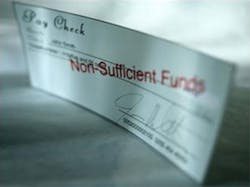If your exterior replacement contracting company is typical, you engage in the standard industry practice of collecting a third of the cost of the job when it’s sold—as a deposit—another third when the job starts, and the balance when the job’s complete, inspected, and OK'ed by your foreman and that homeowner.
So let’s say the job’s done and you’ve collected the last $5,000 on a $15,000 re-shingling job. You deposit the check. Two weeks later, it comes back from the bank, along with a letter, marked NSF—Non-Sufficient Funds.
It doesn’t happen every day or every week, but it will happen from time to time. In fact, bounced checks happen more often today due to electronic check clearing, which means banks don’t have to process the paper check but can work from a digital copy. In the old days, someone could write a check and safely assume that three or four days would elapse before the funds were actually withdrawn. Today, the withdrawal of those funds could happen within hours.
Account Closed
Someone writing you a check that fails to clear is obviously at fault somewhere down the line. But if that check failed to clear because the account has been closed, your problem may be more complicated than figuring out when to redeposit it. As Rebecca Lake points out in “Bank Account Closed? 5 Things You Must Do Next,” banks close accounts for various reasons, such as a record of bounced checks, a frequent negative balance, or due to inactivity.
Craig Berman notes in “What to Do If Someone Writes a Check Against a Closed Bank Account,” that writing a check against a closed account is illegal, and the consequences for the rubber check writer could include either civil action or criminal prosecution.
But you simply want your money. And it’s possible that your client may have made a mistake.
Fees and Thank You
The fact is, however, that it’s far more likely that the account is active and simply doesn’t contain enough money in it to cover a check for $5,000.
Checks bounce for many different reasons. Geri Detweiler provides a list of them in “What You Need to Know About Bounced Checks,” including not balancing the checkbook or forgetting to account for expenditures or withdrawals. In other words, carelessness.
But you’ve done the job and what you have to show for it is a check marked NSF. What now? The Finance Info newsletter article “What To Do When A Client's Check Bounces” suggests that you run the check through again—that is, make a second deposit attempt before contacting the client. They also suggest that you “may want to call the bank first before making the second deposit attempt.”
Mistake or not, it doesn’t matter to the bank. The bank will hit the check writer, your homeowner, with a charge of anywhere from $27 to $35 (the amount is regulated). It’s also possible—in fact likely—that the bank will charge you a fee. In “Another Spurious Bank Fee: $12 For Depositing a Check That Bounces,” LA Times columnist David Lazurus gives this example: “Brian Baltow of Thousand Oaks recently received a check from a client for $120. Unfortunately, the check bounced. Baltow’s bank, returned the check to the guy who wrote it. And it dinged Baltow with a $12 fee.”
On the legal website RocketLawyer, the article “What to Do If You Get a Bounced Check,” notes that in the event of a bounced check, “most banks will send a letter detailing the check number and will charge you a fee (ranging anywhere from $5 to $35).”
Of course that fee, whatever it is, is small change compared to the time and trouble that you now have to take to get the matter cleared up, never mind the aggravation. Some, like this response to a question about “How to Handle Bad Checks” at legal website Freelegaladvice.com, suggest that you call (not email) the client right away and explain that the check didn’t clear. By the way, this is one reason why it’s a good idea, when collecting a check, to write the phone number of the person on the back, so that he/she may be contacted quickly in the event of NSF or a closed account. (Note: This practice is not legal in all states and each state has its own bounced-check laws.)
The call won’t be pleasant, certainly nothing to look forward to. You’ll be irritated and the homeowner will be embarrassed, apologetic, or defensive. So keep the tone of the conversation as polite, businesslike, and unemotional as possible. The goal is not to vent; the goal is to get the money you’re entitled to. If the check didn’t clear, for whatever reason, tell the homeowner you will need either cash or a cashier’s check to make good on what is owed. And give them a firm date for receipt of that payment (that is, immediately follow up with a letter or email, which will be useful in establishing a document trail in the event you need to sue).
It’s also a good idea to have a policy in place regarding NSF checks and to communicate that to clients before work even begins. WalletHub's Richie Bernardo, in “NSF Check: When A Check You Wrote - Or Received - Bounces,” advises charging a fee of between $20 and $40 or a percentage of the check.
$500 More or Less
If you gave the client a deadline on the phone and nothing happened, your next recourse is to send a certified letter. According to Bernardo, “Completing this step is also a prerequisite to taking legal action later, if you need to.”
RocketLawyer recommends that the bad-check notice, which is what it’s called, should include “how much money is due, when you need the payment by, who wrote the check, and the name of their bank,” as well as how to contact you in order to correct the problem. (The website makes available, for a fee, a templated letter and also operates a debt-collection center.)
If the homeowner ignores your certified letter and you’re still out of pocket, you can sue in small claims for the amount of the check and other charges. Your certified letter, containing their signature as being in receipt, will be a potent piece of evidence.
A bounced check becomes a criminal matter when it’s clear that fraud was intended—that is, that the check writer acted to intentionally deceive. “This can be seen as a felony in many states, especially when the checks are for more than $500,” Detweiler points out. “If they are less than $500 and there are criminal charges, it is typically seen as a misdemeanor. The majority of bounced-check cases do not involve criminal penalties, however, as they are done in error and most people quickly cover the expenses.
About the Author

Jim Cory
Philadelphia-based writer Jim Cory is a senior contributing editor to Professional Remodeler who specializes in covering the remodeling and home improvement industry. Reach him at [email protected].
